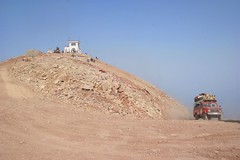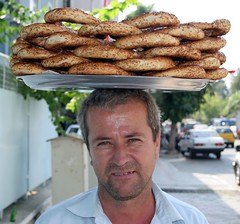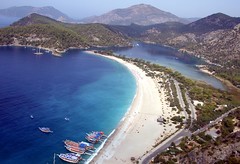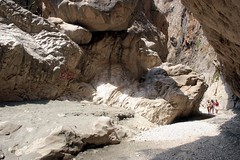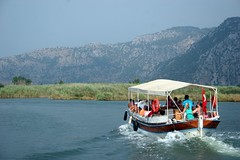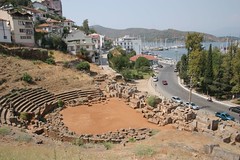Paragliding in Oludeniz
One of the 'must-do' things on any holiday in Oludeniz is paragliding. Having witnessed the braver holidaymakers having a go from the comfort of my hotel balcony, I was prepared to forego any trepidation in favour of the 'once in a lifetime' opportunity to sail the thermals from the top of Babadag Mountain down to the beach at Oludeniz.
So...I booked it and spent the next two days trying to remain focused on the unique opportunity ahead rather than succumb to the horror stories about dodgy take-offs, crash landings and the well-worn tale of 'my brother's friend's girlfiriend's parachute failed to open and she fell into the sea to be eaten by a creature lurking in the Blue Lagoon'.
I had also heard from another holidaymaker that the journey up there was more frightening than jumping off the mountain. I barfed at this suggestion but spent some time trying to assess the steepness of the mountain through my canon zoom lens....neeedless to say....it looked perilous even though I was way too far off to get a serious look. The morning came, I was picked up early and made to wait an interminable amount of time for the instructors to wake up, grab a cigarette, soft drink, macho gear and a couple of paraglides each. The truck was open at the back and sides with tarpaulin stretched over an MDF roof and bars to hold in the paraglides. There were 8 novices loaded into the truck, plus an instructor each, and a driver. That makes 17 people and we are all on board the truck as it made it's way out of Oludeniz and on towards the imposing Babadag Mountain.
The instructors spoke very little English and seemed more concerned with their own images and looking cool to be bothered with the punters. The journey up was hair-raising. The driver took no prsioners. Still I was comforted by the thought that he must make this journey several times every day and knew where the larger 'pot-holes' were. Not content with being bounced around on the floor in the back of the truck, three of the instructors climbed out of the truck and onto the roof to spend the uphill journey bouncing around amongst the paraglides on top. About two-thirds of the way into the journey, the instructors all began to prepare their camcorders, holding them outside the truck and filming in, taking 10 second panoramic shots of the beautiful scenery...all to our bewilderment. We later worked out that the videos were for our benefit as the tour operator attempted to sell us a DVD of our experience almost as soon as we landed.
Arriving on top of Babadag Mountain was a relief...so much so that I took the opportunity to shake the driver's hand and thank him for the white-knuckle ride. The instructor's then chose their novices to pair up with and strap themselves to. I got an instructor who only seemed to know a handful of English words...all of them interspersed with a thumbs up...presumably to ensure I was in tune with him. As we waited for the right thermals as the trigger to take-off, a cavalcade of other trucks arrived, all laden with instructors and novice paragliders. At one stage there must have been close to 100 people on top of the mountain and the pressure was building upon our instructors to get going. The instructors began talking loudly, arguing, gesticulating and then diving onto paraglides as a mini tornado swirled across the mountain and whipped up some paraglides. The term tornado is not really indicative of the situation but the effect on laid-out paraglides and instructors was very real.
 Eventually, my time arrived. I was told (in poor English) to run. Strapped to my instructor I began running only to be hauled back as the paraglide inflated and then told to furiously run again as it settled. Two, three, four steps and off rising and soaring above the mountain, dipping, diving, rising to catch the thermal for what seemed like an eternity..or at least that is how my stomach recalls it. On several occasions I had to close my eyes, even though the view was breathtaking. We eventually settled into a thermal and began the descent down towards the beach at Oludeniz and the Blue Lagoon. I later found out that we had jumped off from 6500 feet. The view takes your breath away and with the adrenalin running high, I was able to take photographs. There is a selection of them below to illustrate the beauty of the place and there are many more on Flickr, and in another earlier blog post 'Oludeniz and the Blue Lagoon'.
Eventually, my time arrived. I was told (in poor English) to run. Strapped to my instructor I began running only to be hauled back as the paraglide inflated and then told to furiously run again as it settled. Two, three, four steps and off rising and soaring above the mountain, dipping, diving, rising to catch the thermal for what seemed like an eternity..or at least that is how my stomach recalls it. On several occasions I had to close my eyes, even though the view was breathtaking. We eventually settled into a thermal and began the descent down towards the beach at Oludeniz and the Blue Lagoon. I later found out that we had jumped off from 6500 feet. The view takes your breath away and with the adrenalin running high, I was able to take photographs. There is a selection of them below to illustrate the beauty of the place and there are many more on Flickr, and in another earlier blog post 'Oludeniz and the Blue Lagoon'.
So...I booked it and spent the next two days trying to remain focused on the unique opportunity ahead rather than succumb to the horror stories about dodgy take-offs, crash landings and the well-worn tale of 'my brother's friend's girlfiriend's parachute failed to open and she fell into the sea to be eaten by a creature lurking in the Blue Lagoon'.
I had also heard from another holidaymaker that the journey up there was more frightening than jumping off the mountain. I barfed at this suggestion but spent some time trying to assess the steepness of the mountain through my canon zoom lens....neeedless to say....it looked perilous even though I was way too far off to get a serious look. The morning came, I was picked up early and made to wait an interminable amount of time for the instructors to wake up, grab a cigarette, soft drink, macho gear and a couple of paraglides each. The truck was open at the back and sides with tarpaulin stretched over an MDF roof and bars to hold in the paraglides. There were 8 novices loaded into the truck, plus an instructor each, and a driver. That makes 17 people and we are all on board the truck as it made it's way out of Oludeniz and on towards the imposing Babadag Mountain.
The instructors spoke very little English and seemed more concerned with their own images and looking cool to be bothered with the punters. The journey up was hair-raising. The driver took no prsioners. Still I was comforted by the thought that he must make this journey several times every day and knew where the larger 'pot-holes' were. Not content with being bounced around on the floor in the back of the truck, three of the instructors climbed out of the truck and onto the roof to spend the uphill journey bouncing around amongst the paraglides on top. About two-thirds of the way into the journey, the instructors all began to prepare their camcorders, holding them outside the truck and filming in, taking 10 second panoramic shots of the beautiful scenery...all to our bewilderment. We later worked out that the videos were for our benefit as the tour operator attempted to sell us a DVD of our experience almost as soon as we landed.
Arriving on top of Babadag Mountain was a relief...so much so that I took the opportunity to shake the driver's hand and thank him for the white-knuckle ride. The instructor's then chose their novices to pair up with and strap themselves to. I got an instructor who only seemed to know a handful of English words...all of them interspersed with a thumbs up...presumably to ensure I was in tune with him. As we waited for the right thermals as the trigger to take-off, a cavalcade of other trucks arrived, all laden with instructors and novice paragliders. At one stage there must have been close to 100 people on top of the mountain and the pressure was building upon our instructors to get going. The instructors began talking loudly, arguing, gesticulating and then diving onto paraglides as a mini tornado swirled across the mountain and whipped up some paraglides. The term tornado is not really indicative of the situation but the effect on laid-out paraglides and instructors was very real.
 Eventually, my time arrived. I was told (in poor English) to run. Strapped to my instructor I began running only to be hauled back as the paraglide inflated and then told to furiously run again as it settled. Two, three, four steps and off rising and soaring above the mountain, dipping, diving, rising to catch the thermal for what seemed like an eternity..or at least that is how my stomach recalls it. On several occasions I had to close my eyes, even though the view was breathtaking. We eventually settled into a thermal and began the descent down towards the beach at Oludeniz and the Blue Lagoon. I later found out that we had jumped off from 6500 feet. The view takes your breath away and with the adrenalin running high, I was able to take photographs. There is a selection of them below to illustrate the beauty of the place and there are many more on Flickr, and in another earlier blog post 'Oludeniz and the Blue Lagoon'.
Eventually, my time arrived. I was told (in poor English) to run. Strapped to my instructor I began running only to be hauled back as the paraglide inflated and then told to furiously run again as it settled. Two, three, four steps and off rising and soaring above the mountain, dipping, diving, rising to catch the thermal for what seemed like an eternity..or at least that is how my stomach recalls it. On several occasions I had to close my eyes, even though the view was breathtaking. We eventually settled into a thermal and began the descent down towards the beach at Oludeniz and the Blue Lagoon. I later found out that we had jumped off from 6500 feet. The view takes your breath away and with the adrenalin running high, I was able to take photographs. There is a selection of them below to illustrate the beauty of the place and there are many more on Flickr, and in another earlier blog post 'Oludeniz and the Blue Lagoon'.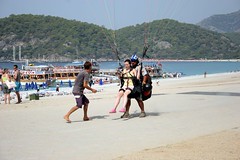 Landing was a breeze...or at least i though it was. Two or three steps and down onto the beach. My instructor was furious...not with me...he seemed to be taking it out on the helper who had run out onto the beach. I later worked out that we were supposed to land on the concrete strips off the beach and not into sand but it didn't dampen my experience one bit.
Landing was a breeze...or at least i though it was. Two or three steps and down onto the beach. My instructor was furious...not with me...he seemed to be taking it out on the helper who had run out onto the beach. I later worked out that we were supposed to land on the concrete strips off the beach and not into sand but it didn't dampen my experience one bit.It was an experience not to be missed and I was ready to go all the way back up and jump off again. I had spent about 25 minutes in the air with some of the most outstanding views I have ever seen. I was trembling at the end...not from fear or fright...but from sheer enjoyment. I would thoroughly recommend it...so too would both of my daughters, who also experienced the whole thing with me.
